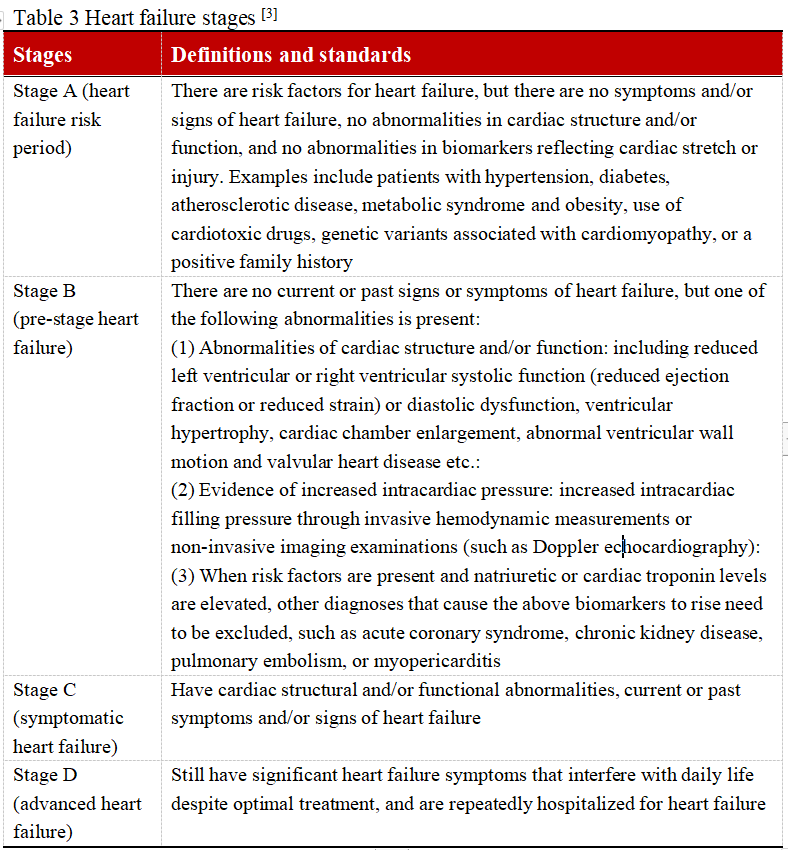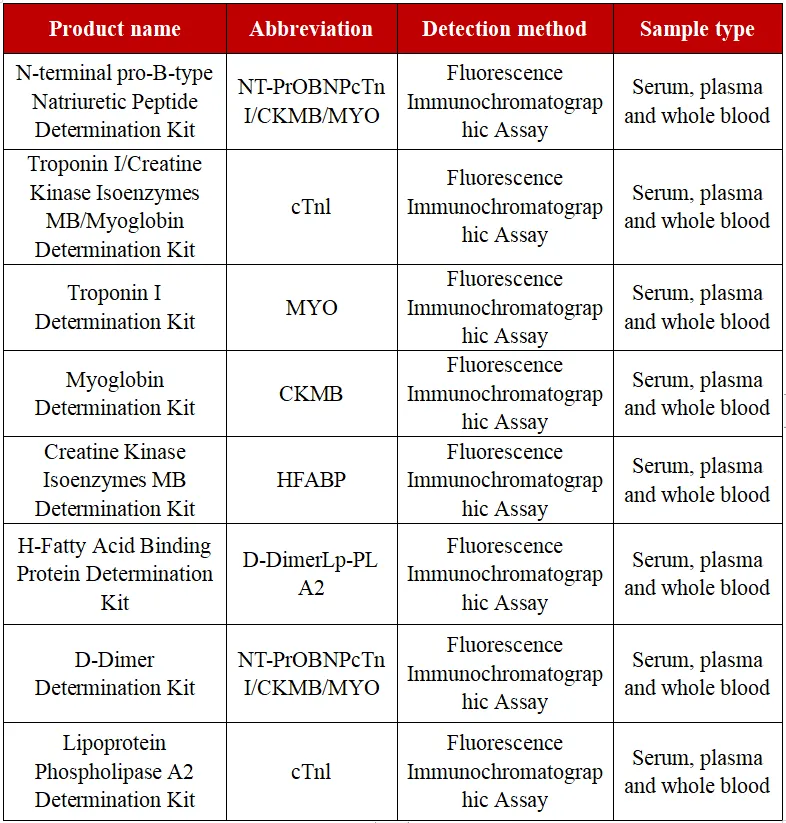The growing burden of heart failure
Heart failure (HF) is a group of clinical syndromes caused by abnormalities in cardiac structure and/or function leading to impaired ventricular filling and/or ejection capacity. Heart failure can be divided into chronic heart failure (CHF) and acute heart failure (AHF) according to the time and speed of its occurrence.
Heart failure is the terminal stage of various heart diseases and is characterized by high morbidity, mortality, hospitalization rates, poor patient quality of life, and high medical costs. According to the occurrence and development process of heart failure, it can be divided into 4 stages: stage A is the risk stage of heart failure, stage B is the pre-heart failure stage, stage C is the symptomatic heart failure stage, and stage D is the advanced stage of heart failure [1].
A 2015 study showed that the prevalence of heart failure in people aged ≥ 35 years in China was 1.3% (1.2% for women, 1.4% for men), and there were an estimated 8.9 million heart failure patients [2]. Heart failure has become an important public health issue affecting residents' health. The per capita cost for inpatients with heart failure is 29,746 yuan/year, of which 40.5% are hospitalized ≥3 times, with an average hospitalization of 9.7 days; the per capita outpatient cost for heart failure patients is 6,023 yuan/year. As China's population ages, the burden of heart failure will gradually increase [3].
The best marker of heart failure--BNP/NTproBNP
The natriuretic peptide family is a group of peptides with similar structures but different origins, including atrial natriuretic peptide (ANP, type A), brain natriuretic peptide (BNP, type B) and C-type natriuretic peptide (CNP, C-type).
BNP and NT-proBNP (N-terminal B-type natriuretic peptide precursor) in the natriuretic peptide family are currently routinely carried out by clinical laboratory departments. They have
the highest recommended category among all biomarkers for heart failure and has now become the most important biomarker for the identification, diagnosis and prognosis evaluation of high-risk groups of heart failure [4]. Overall, the clinical application value of BNP and NT-proBNP in patients with heart failure is equivalent. Clinicians should choose to test BNP or NT-proBNP according to the different conditions of the patient.
For patients with acute chest pain or dyspnea, BNP or NT-proBNP should be detected to rule out the possibility of heart failure. When BNP <100 ng/L and NT-proBNP <300 ng/L, the possibility of acute heart failure can usually be ruled out; while when BNP <35 ng/L and NT-proBNP <125 ng/L, the possibility of chronic heart failure can be ruled out [ 5].
Although heart failure is a progressive disease, it is preventable and may be reversed with early intervention. Therefore, detecting BNP or NT-proBNP in the early stage of heart failure is very important to improve patient prognosis. It also plays an important role in the severity assessment, risk stratification and prognosis judgment of acute chest pain [6].
Diagreat Biotech Heart Failure--NT-proBNP Rapid Test Solution
Diagreat Biotech's N-terminal pro-B-type Natriuretic Peptide Determination Kit (Fluorescence Immunochromatographic Assay) is one of the rapid test products of Diagreat’s myocardial marker series and is suitable for patients with suspected heart failure and acute chest pain. Only 20 μL of serum or plasma sample is needed to achieve rapid, precise and quantitative detection of NT-proBNP in patients,
with results available in 20 minutes .
For people at high risk of heart failure, this test can be performed and corresponding intervention can be carried out to prevent or delay the occurrence of heart failure. For patients with suspected heart failure, this test can enable early treatment and improve prognosis. NT-proBNP testing can also be used to guide heart failure treatment.
Advantage of Diagreat Biotech’s POCT platform (Fluorescence Immunochromatographic Assay)
“ Portable instrument ”
" Quick detection "
" Simple operation "
Diagreat POCT myocardial marker series ordering information

References:
[1] National Center for Cardiovascular Diseases, Heart Failure Professional Committee of the National Cardiovascular Disease Expert Committee, Heart Failure Professional Committee of the Chinese Medical Doctor Association, etc. National Heart Failure Guidelines 2023 (Simplified Version) [J]. Chinese Journal of Circulation, 2023, 38(12): 1207-1238.
[2] Hao G, Wang X, Chen Z, et al. Prevalence of heart failure and left ventricular dysfunction in China: the China Hypertension Survey, 2012 2015 [J]. Eur J Heart Fail, 2019, 21(11):13291337.
[3] Wang H, Chai K, Du M, et al. Prevalence and incidence of heart failure among urban patients in China: a national populationbased analysis [J]. Circ Heart Fail, 2021, 14(10): e008406.
[4] Heart Failure Professional Committee of the Chinese Medical Doctor Association, Heart Failure Professional Committee of the National Cardiovascular Disease Expert Committee, Editorial Committee of the Chinese Journal of Heart Failure and Cardiomyopathy. Clinical Application of Heart Failure Biomarkers in China Expert consensus [J]. Chinese Journal of Heart Failure and Cardiomyopathy, 2022, 6(3): 175-192.
[5] Consensus Expert Group on Joint Detection of Cardiovascular Markers for Emergency Chest Pain, Emergency Medicine Branch of China Association for the Promotion of International Exchange of Healthcare. Expert consensus on cardiovascular marker detection for emergency chest pain [J]. Chinese Journal of Emergency Medicine, 2022, 31(4): 448-458.
[6] Chinese Medical Association Emergency Medicine Branch, China Healthcare International Exchange Promotion Association Chest Pain Branch. Expert consensus on emergency diagnosis and treatment of acute chest pain [J]. Chinese Journal of Emergency Medicine, 2019, 28(4): 413-420.